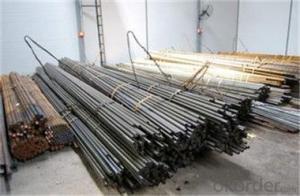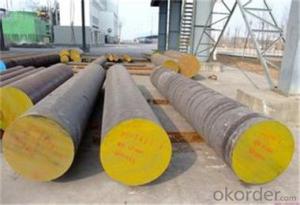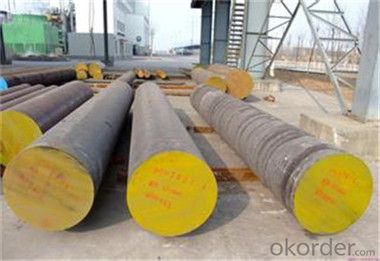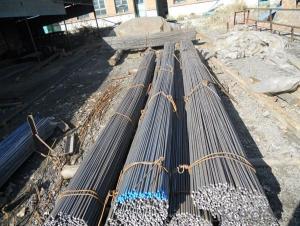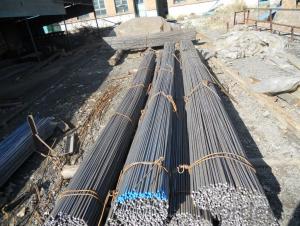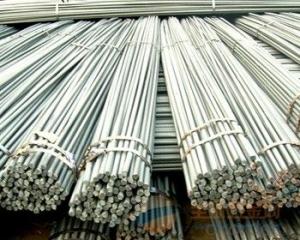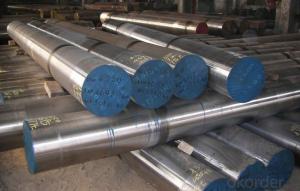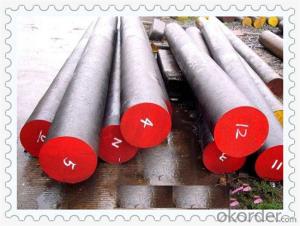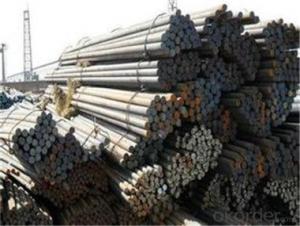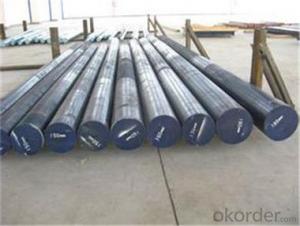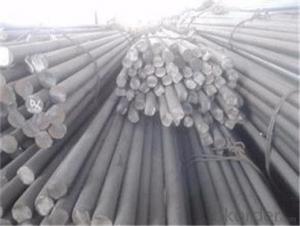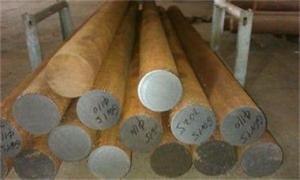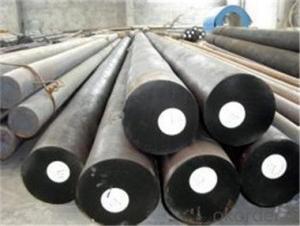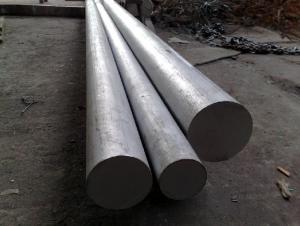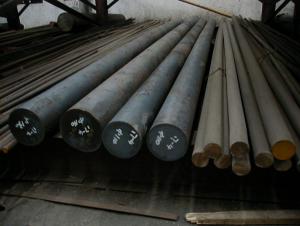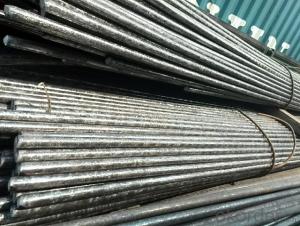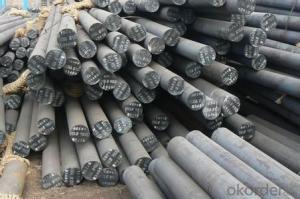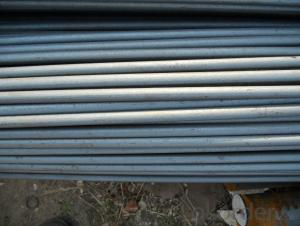Hard Chrome Carbon Steel Round Bar in CNBM
- Loading Port:
- Shanghai
- Payment Terms:
- TT OR LC
- Min Order Qty:
- 8900 m.t.
- Supply Capability:
- 200008888 m.t./month
OKorder Service Pledge
OKorder Financial Service
You Might Also Like
Description of steel round bar:
1.Diameter 80 to 800 mm
2.Black or Bright surface
Festures of steel round bar:
4340 Forged Round Steel Bar Dia 80-800mm Length:2000-13000mm or as required
Specifications of steel round bar:
Description |
Carbon Steel Rod/Carbon Steel Bar,carboteel bar | |
Material | ASTM | 1005,1006,1008,1010,10 |
DIN | Ck10,Ck15,Ck22,Ck25,Ck30,Ck35,Ck40,Ck45,Ck50, 30Mn4,40Mn4 | |
BS | 040A04,095M15,045M10 | |
Standard | GB/T799,ASTM A29,A108,A321,A575 | |
Section shape |
Round | |
Length |
As your required | |
Application | Carbon steel rod applies to chemical industry,electric power, pump shafts, sanitary wares,furniture handles,boiler,high temperature resistant,low temperature resistant, corrosion resistant. | |
Images of steel round bar:
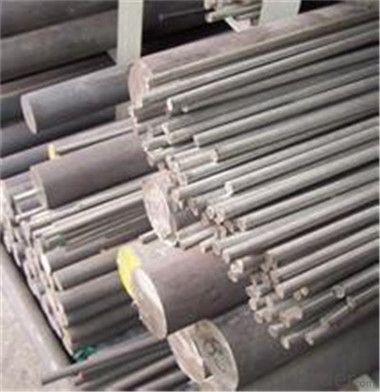
FAQ:
1. What is your package?
Packing situation: standard seaworthy packing or as customer required.
2. How long is the lead time?
Delivery time: 60 days after order confirmed.
- Q: What is the difference between hot working and cold working of steel round bars?
- Hot working and cold working are two different methods used to shape and manipulate steel round bars. Hot working refers to the process of shaping steel at elevated temperatures, typically above the recrystallization temperature of the steel. This allows for the material to be more malleable and easier to shape. Hot working processes include forging, rolling, and extrusion. One of the main advantages of hot working is that it allows for the material to be formed into complex shapes and sizes with minimal force or energy. It also helps to refine the grain structure of the steel, improving its mechanical properties such as strength and toughness. However, hot working can cause oxidation and scale formation on the surface of the steel, which may require additional surface treatments or cleaning. Cold working, on the other hand, involves shaping steel at room temperature or below its recrystallization temperature. Cold working processes include bending, drawing, and cold rolling. Unlike hot working, cold working does not require heating the steel, which can save energy and reduce production costs. It also produces a smoother surface finish and tighter tolerances compared to hot working. Cold working can increase the hardness and strength of the steel, making it suitable for applications that require higher mechanical properties. However, cold working can also make the steel more brittle and prone to cracking. In summary, the main difference between hot working and cold working of steel round bars is the temperature at which the shaping process takes place. Hot working is done at elevated temperatures, allowing for easier shaping and improved mechanical properties, while cold working is done at room temperature or below, resulting in tighter tolerances and increased hardness. The choice between hot working and cold working depends on the desired properties and characteristics of the final product.
- Q: How about tempering No. 45 round bar?
- During quenching and tempering, the whole section of the workpiece is quenched and the microstructure of the workpiece is obtained with fine acicular quenched martensite. By tempering at high temperature, the microstructure with uniform tempered bainite is obtained. It is impossible for a small factory to do metallographic analysis of each furnace. It is generally used only for hardness testing. That is to say, the hardness of the quenched material must be reached by the quenching hardness of the material, and the hardness after tempering shall be checked according to the requirements of the drawing.
- Q: What is the maximum silicon content allowed for steel round bars?
- The maximum silicon content permitted in steel round bars may differ based on the particular grade and application of the steel. Nonetheless, in general, the majority of standard carbon and alloy steels utilized in round bars usually have a maximum silicon content ranging from 0.35% to 0.45%. Going beyond this threshold can result in adverse consequences for the mechanical properties of the steel, including diminished toughness and heightened brittleness. To ascertain the precise maximum silicon content permitted for a specific steel grade and intended use, it is crucial to refer to the applicable industry standards and specifications.
- Q: What are the advantages of using alloy steel round bars?
- There are several advantages of using alloy steel round bars. Firstly, alloy steel round bars offer superior strength and durability compared to regular steel bars. This makes them ideal for applications where high strength and toughness are required, such as in construction, automotive, and aerospace industries. The alloying elements in these bars enhance their mechanical properties, making them more resistant to wear, impact, and corrosion. Additionally, alloy steel round bars have excellent heat resistance. They can withstand high temperatures without losing their strength, making them suitable for use in high-temperature environments like furnaces, boilers, and heat exchangers. This property allows for extended service life and reduces the need for frequent replacements. Another advantage of using alloy steel round bars is their versatility. These bars can be easily machined, forged, or welded, allowing for flexibility in design and manufacturing processes. They can be customized to meet specific requirements, making them suitable for various applications. Furthermore, alloy steel round bars have good dimensional stability. They maintain their shape and size even under extreme conditions, ensuring precise and accurate performance. This property is particularly important in applications where tight tolerances are required, such as in precision engineering and manufacturing industries. Lastly, alloy steel round bars are cost-effective in the long run. Although they may have a higher initial cost compared to regular steel bars, their enhanced properties and extended service life result in reduced maintenance and replacement costs. This makes them a more economical choice in the long term. In conclusion, the advantages of using alloy steel round bars include superior strength and durability, excellent heat resistance, versatility in machining and fabrication, good dimensional stability, and long-term cost-effectiveness. These benefits make them a preferred choice in various industries where high-performance materials are required.
- Q: What are the different types of surface treatments for steel round bars?
- There are several types of surface treatments commonly used for steel round bars. These include hot-dip galvanizing, electroplating, painting, powder coating, and black oxide coating. Each treatment offers specific benefits and is chosen based on the desired level of corrosion resistance, aesthetics, and durability required for the application.
- Q: What are the advantages of using heat-resistant steel round bars?
- The advantages of using heat-resistant steel round bars include high thermal stability, excellent resistance to oxidation and corrosion at elevated temperatures, superior strength and toughness, and the ability to retain their mechanical properties even under extreme heat conditions. Heat-resistant steel round bars also have good dimensional stability, making them suitable for applications in high-temperature environments such as furnace components, heat exchangers, and power generation equipment.
- Q: Can steel round bars be used for making automotive chassis?
- Yes, steel round bars can be used for making automotive chassis. Steel is a commonly used material in automotive chassis due to its high strength and durability. Round bars made of steel provide excellent structural integrity and can withstand the heavy loads and forces experienced by a vehicle's chassis. The use of steel round bars in automotive chassis also helps improve the overall safety of the vehicle by providing a strong and rigid frame. Additionally, steel is relatively cost-effective and readily available, making it a popular choice for automotive manufacturers.
- Q: Can steel round bars be used in the manufacturing of automotive parts?
- Yes, steel round bars can indeed be used in the manufacturing of automotive parts. Steel round bars offer several advantages that make them suitable for this purpose. Firstly, steel is a strong and durable material, making it ideal for automotive components that require high strength and structural integrity. Additionally, steel round bars can be easily machined and formed into various shapes and sizes, allowing for the production of customized automotive parts. Moreover, steel has excellent heat resistance and can withstand high temperatures, making it suitable for engine components and other parts exposed to extreme heat. Lastly, steel is a cost-effective material, making it a popular choice in the automotive industry. Overall, steel round bars are a reliable and versatile option for the manufacturing of automotive parts.
- Q: What are the different types of steel round bars used in the manufacturing of cutting tools?
- There are several different types of steel round bars that are commonly used in the manufacturing of cutting tools. Some of the most commonly used types include: 1. High-Speed Steel (HSS): This type of steel is known for its excellent hardness, wear resistance, and ability to retain its cutting edge at high temperatures. HSS round bars are often used in the manufacturing of drills, end mills, and other cutting tools that are used for metalworking and high-speed applications. 2. Tool Steel: Tool steel round bars are widely used in the production of cutting tools due to their high strength, toughness, and resistance to wear and deformation. Different grades of tool steel, such as D2, A2, and O1, are chosen based on the specific application and requirements of the cutting tool. 3. Carbon Steel: Carbon steel round bars are commonly used in the manufacturing of cutting tools that are designed for softer materials, such as wood and plastics. Carbon steel offers good hardness and durability, making it suitable for a wide range of cutting applications. 4. Stainless Steel: Stainless steel round bars are often used in the manufacturing of cutting tools that require high corrosion resistance and strength. Stainless steel offers good durability, toughness, and edge retention, making it a popular choice for cutting tools used in the food industry, medical field, and other applications where cleanliness and hygiene are important. 5. Alloy Steel: Alloy steel round bars are made by adding various alloying elements, such as chromium, molybdenum, and vanadium, to improve the properties of the steel. Alloy steel offers enhanced hardness, strength, and wear resistance, making it suitable for cutting tools used in demanding applications, such as machining hardened materials and high-temperature cutting. It is important to choose the appropriate type of steel round bar based on the specific requirements of the cutting tool, including the material being cut, the desired cutting speed, and the expected operating conditions.
- Q: What are the different types of connections used with steel round bars?
- Different types of connections are commonly used with steel round bars, depending on the specific application and structural requirements. Some examples of these connections include: 1. Welded Connections: Steel round bars can be fused together using heat and pressure in a process called welding. This method is widely used and results in a strong and durable connection. 2. Mechanical Connections: Bolts, nuts, or other mechanical fasteners can be employed to join steel round bars together. These connections are easy to install and can be disassembled if necessary, making them ideal for applications requiring frequent disassembly or reconfiguration. 3. Threaded Connections: By cutting threads into the ends of steel round bars, they can be screwed together using nuts. This type of connection offers good strength and can be easily tightened or loosened. 4. Adhesive Connections: High-strength adhesives or epoxies can be used to bond steel round bars together when welding or mechanical connections are not feasible or desirable. This method is commonly used in such situations. 5. Interlocking Connections: Specially designed couplers or connectors can be used to fit over the ends of steel round bars, creating a secure interlocking connection. These connections are often utilized in construction projects where quick and efficient installation is required. 6. Grouted Connections: The gaps between steel round bars can be filled with a cementitious grout material to enhance strength and stability. Grouted connections are commonly used in applications that require high load capacities. To ensure the correct type of connection is chosen for steel round bars, it is crucial to consider factors such as load capacity, installation ease, disassembly requirements, and structural integrity. Consulting with a structural engineer or a professional in the field is recommended.
Send your message to us
Hard Chrome Carbon Steel Round Bar in CNBM
- Loading Port:
- Shanghai
- Payment Terms:
- TT OR LC
- Min Order Qty:
- 8900 m.t.
- Supply Capability:
- 200008888 m.t./month
OKorder Service Pledge
OKorder Financial Service
Similar products
Hot products
Hot Searches
Related keywords
